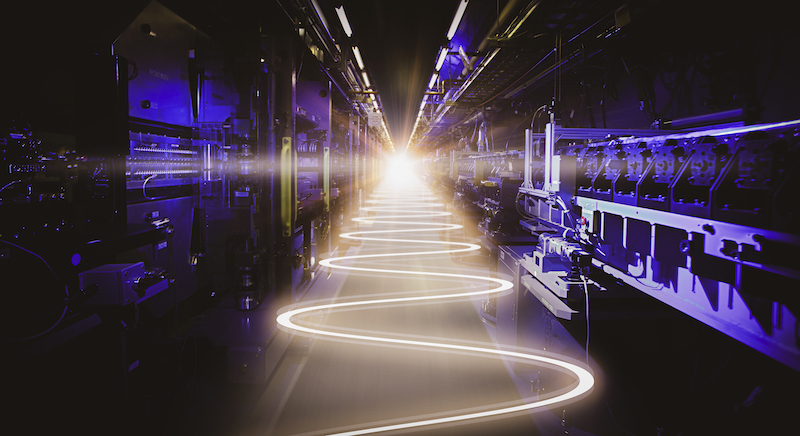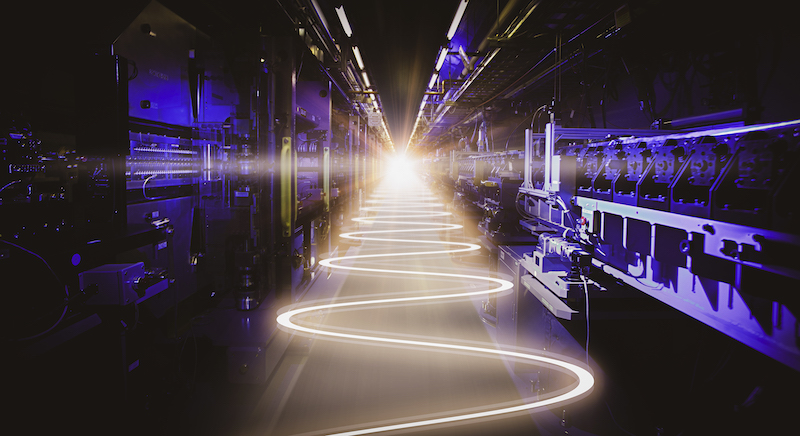First Light for a Next-Generation Light Source
X-ray free-electron lasers (XFELs) first came into existence two decades ago. They have since enabled pioneering experiments that “see” both the ultrafast and the ultrasmall. Existing devices typically generate short and intense x-ray pulses at a rate of around 100 x-ray pulses per second. But one of these facilities, the Linac Coherent Light Source (LCLS) at the SLAC National Accelerator Laboratory in California, is set to eclipse this pulse rate. The LCLS Collaboration has now announced “first light” for its upgraded machine, LCLS-II. When it is fully up and running, LCLS-II is expected to fire one million pulses per second, making it the world’s most powerful x-ray laser.
The LCLS-II upgrade signifies a quantum leap in the machine’s potential for discovery, says Robert Schoenlein, the LCLS’s deputy director for science. Now, rather than “demonstration” experiments on simple, model systems, scientists will be able to explore complex, real-world systems, he adds. For example, experimenters could peer into biological systems at ambient temperatures and physiological conditions, study photochemical systems and catalysts under the conditions in which they operate, and monitor nanoscale fluctuations of the electronic and magnetic correlations thought to govern the behavior of quantum materials.
The XFEL was first proposed in 1992 to tackle the challenge of building an x-ray laser. Conventional laser schemes excite large numbers of atoms into states from which they emit light. But excited states with energies corresponding to x-ray wavelengths are too short-lived to build up a sizeable excited-state population. XFELs instead rely on electrons traveling at relativistic speed through a periodic magnetic array called an undulator. Moving in a bunch, the electrons wiggle through the undulator, emitting x-ray radiation that interacts multiple times with the bunch and becomes amplified. The result is a bright x-ray beam with laser coherence.
The first XFEL was built in Hamburg, Germany, in 2005. Today that XFEL emits “soft” x-ray radiation, which has wavelengths as short as a few nanometers. LCLS switched on four years later and expanded XFEL’s reach to the much shorter wavelengths of “hard” x rays, which are essential to atomic-resolution imaging and diffraction experiments. These and other facilities that later appeared in Japan, Italy, South Korea, Germany, and Switzerland have enabled scientists to probe catalytic reactions in real time, solve the structures of hard-to-crystallize proteins, and shed light on the role of electron–photon coupling in high-temperature superconductors. The ability to record movies of the dynamics of molecules, atoms, and even electrons also became possible because x-ray pulses can be as short as a couple of hundred attoseconds.
The upgrades to LCLS offer a new mode of XFEL operation, in which the facility delivers an almost continuous x-ray beam in the form of a megahertz pulse train. For the original LCLS, the pulse rate, which maxed out at 120 Hz, was set by the properties of the linear accelerator that produced the relativistic electrons. Built out of copper, a conventional metal, and operated at room temperatures, the accelerator had to be switched on an off 120 times per second to avoid heat-induced damage. In LCLS-II some of the copper has been replaced with niobium, which is superconducting at the operating temperature of 2 K. Bypassing the damage limitations of copper, the dissipationless superconducting elements allow an 8000-fold gain in the maximum repetition rate. The new superconducting technology is also expected to reduce “jitter” in the beam, says LCLS director Michael Dunne. Greater stability and reproducibility, higher repetition rate, and increased average power “will transform our ability to look at a whole range of systems,” he adds.
LCLS-II is a boon for time-resolved chemistry-focused experiments, says Munira Khalil, a physical chemist at the University of Washington in Seattle. Khalil, a user of LCLS, plans to take advantage of the photon bounty of the rapid-fire pulses to perform dynamical experiments. She hopes such experiments may fulfill “a chemist’s dream”: real-time observations of the coupled motion of atoms and electrons. With extra photons, scientists could also probe dilute samples, potentially shedding light on how metals bind to specific sites in proteins—a process relevant to the function of half of all of nature’s proteins.
The megahertz pulse rate also means that experiments that previously took days to perform could now be completed in hours or minutes, says Henry Chapman of the Center for Free Electron Laser Science at DESY, Germany. At LCLS and later at Hamburg’s XFEL, Chapman ran pioneering experiments to determine the structures of proteins. The method he used, called serial crystallography, involves merging the diffraction patterns of multiple samples sequentially injected into the XFEL’s beam. Serial crystallography has allowed scientists to determine the structures of biologically relevant proteins that form crystals too small to study with conventional crystallography techniques. Chapman says that the increased throughput enabled by LCLS-II will permit much more ambitious experiments, such as measurements of biomolecular reactions on timescales from femtoseconds to milliseconds. “One could also think of an ‘on the fly’ analysis that feeds back into the experiment to discover optimal conditions for drug binding or catalysis,” he says.
For Khalil, the dramatic speedup of the experiments is a key advance of LCLS-II, as she thinks it will make these kinds of experiments accessible to a wider group of people. Until now, she says, XFEL facilities were mostly used by people who had the opportunity to work extensively at XFELs as postdocs or graduate students. Many more experimenters should now be able to enter the XFEL arena, she says. “It’s an exciting time for the field.”
–Matteo Rini
Matteo Rini is the Editor of Physics Magazine.





